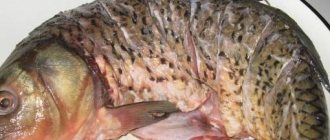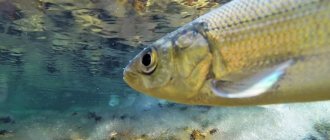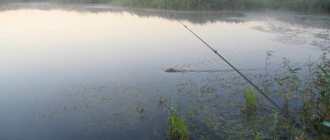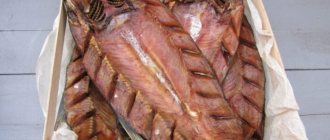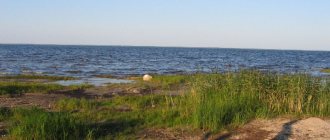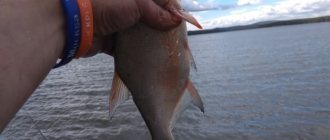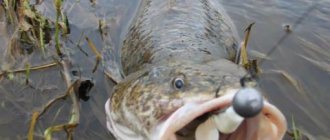Description of the reservoir
The Nara is a small river that flows in the Kaluga and Moscow regions. Left tributary of the Oka. Has the following characteristics:
- channel length – 158 km;
- drainage basin area – 2030 sq. km;
- water consumption - 5.07 cubic meters. meters per second;
- the slope is directed to the south.
The Nara River originates from Lake Poletskoye, located in the Odintsovo district of the Moscow region. It flows into the Oka near the city of Serpukhov, the administrative center of the urban district.
In the upper reaches of the river there are the Nara ponds of the famous fish factory, where valuable species of ichthyofauna are grown. The banks are flat and swampy in places. The width of the channel is 10–15 meters, depths from 50 cm to 2.5 meters.
For reference! Nara has a calm bottom topography throughout its entire length.
In the middle and lower reaches, the Nara channel widens to 30–40 meters, in some places up to 80 meters. The average depth is 2.5 meters, there are holes up to 5-6 meters. The bottom topography is relatively calm, without sharp drops and drops. The banks are elevated, in places overgrown with bushes.
The Nara flows through the territory of the Moscow and Kaluga regions
Throughout its length, Nara receives water from streams and several small rivers. The main ones are:
- Istya;
- Berezovka;
- Gvozdnya;
- Blueberry;
- Kremenka;
- Mold;
- Trasna;
- Inevka;
- Tarussa.
In the Serpukhov region, the Serpeika stream flows into the Nara. You can also note Mint, Chavra and Temenka.
The Nara River is fed predominantly by snow. It freezes in December and opens in March. The spring flood occurs in April - early May. Low water occurs in July. Rain floods often occur in September–October.
Note! The mouth section of the Nara is navigable. There is a settling point for boats and barges here.
There is a dam in the Serpukhov area on the Nara
Today, unfortunately, the Nara River is experiencing strong anthropogenic pressure associated with industrial and domestic human activities. Effluents from enterprises enter the reservoir, polluting the water, reducing its quality, and affecting the reduction of fish stocks.
general description
The Nara River is 158 kilometers long. Its basin is 2,030 square kilometers. The maximum width was recorded in Dyutkovsky Pond (2 km). The depth reaches 2 meters (only on the main reaches, in other places no more than 1.5 m). Starting in the Odintsovo urban district of the Moscow region, the reservoir passes through Naro-Fominsk. And it ends in Serpukhovsky - in its administrative part, on the very border with the Kaluga region. The “water road” still covers some of its areas on the way to Serpukhov. The general direction of the river is southeast. The average water flow is more than 5.07 cubic meters per second. The feeding of the hydrological object is mixed, mainly snow. Freeze-up lasts from early December to early April. The flood begins in April-May. The rise in water level does not exceed the norm, since the reservoir is regulated by dams in the area of the Nara ponds. Because of this, the river route is straightened in some places with the help of canals. There are about 18 tributaries of this river (excluding streams). The large ones are Istya, Tarussa, Bukhlovka, Stydinka, Moskovka, Gvozdnya, Desenka, Inevka, Rechma and Plesenka. Previously, Serpeika (one of the rivers of Serpukhov) was also very noticeable...
The Nara River was formed simultaneously with the Moscow Plateau (part of the Smolensk-Moscow Upland). Once upon a time, the artery formed a single watercourse with the Moscow River, but Lake Poletsk did not exist. People have settled on the riverine hills since the Stone Age (Vyshgorod site). The aborigines were supplanted by the Proto-Indo-Europeans of the Fatyanovo culture. In the description of the Nara River, philologists tell us: the hydronym is of Baltic origin (from the entire Fatyanovo massif, the Balts remained to live on the river). In the very lower reaches of 1 thousand already. e. Vyatichi appear.
And several Slovenian clans. The Finno-Ugrians (descendants of the Dyakovo culture) are moving north... So, among the chronicle golyad, “nara” meant “stream”. The concept is ancient. Once upon a time, all tribes of Fatyanovo-Zarubinets origin called the stream “innar” - hence the Slavic-Baltic-Scandinavian-German derivatives: Ra, Inna, Inga, Inar, Narra and Inra (“strem”, “strom” and “strema” appeared later). The Vyatichi were part of the Khazar Kaganate. During the period of Kievan Rus and the Horde, the hydrological object was transferred to different states several times. Lithuania created more problems (during the reign of Ivan IV, the most massive review of troops was held in Serpukhov). The local towns burned to the ground more than once. In the same era, the area flourished with monasteries. They strengthen the spirit of desperate villagers. Transport use of the Nara River was widespread (it is still navigable in its lower reaches). Finally, after the end of the Time of Troubles and the victory over the Polish-Lithuanian invaders, from source to mouth, the Nara River began to belong to the Russian state. And in the times of Peter the Great, she, like Oka, participated in the creation of the Russian fleet. Note that shipbuilders are recruited from Serpukhov and Naro-Fominsk. During the War of 1812, Nara villages were a resting place for Napoleon’s troops. In the 1930s, the watercourse was transformed - fish farms were created. First, the Nara ponds are built for them (hydraulic builders dig basins and build dams). During the Second World War, the Nara River was at the heart of the battles related to the Naro-Fominsk operations of the Red Army. Defensive and offensive. Since the late 40s, new villages have been added. By the way, at one time 5 “nests of nobles” appeared closer to Serpukhov. Today all estates are monuments (open museum-reserves)…
Fishing
Fishing on the Nara River is not particularly popular among residents of the Moscow region. The reservoir is visited mainly by local residents who, for various reasons, cannot travel to more promising places. Nevertheless, you can catch fish and get your share of pleasure and adrenaline.
Spinning fishing in this reservoir is no different from fishing in any other small river. The most universal bait is considered to be a banal spinner of small or medium size; microjig shows good results; some amateurs prefer to use miniature crankbaits and minnows; in the summer it makes sense to try topwaters.
You can fish with a float on the Nara all year round
The float rod works all year round. With its help, you can hunt for almost all local underwater inhabitants, even predatory ones, using a running donkey. Of the baits, preference should be given to worms and maggots. In hot weather, you can put dough or steamed wheat grains on the hook.
Advice! In spring, roach and silver bream come from Oka to Nara to spawn.
In the lower reaches of the Nara, a light feeder or picker is quite suitable. In many places, feeders weighing up to 40–50 grams are sufficient. In the catch you can expect a weighty silver bream, plump roach, and commercial bream. But mostly a palm-sized “laurel” sits on the hook.
In the lower reaches of the Nara you can fish with a light feeder
In winter, fishermen do not spoil Nara with their presence. If, nevertheless, you find yourself here in the cold season, then you should look for fish in the coastal zone on the edges, in the area where streams and rivulets flow into the main channel, in oxbow lakes and backwaters. From the gear it is better to choose a jig, and on the first ice it is good to catch perch using small vertical lures.
Serpukhov, weather forecast and fish bite
| Weather forecast and fish bite | Fishing calendar, from 01-07-2021 to 04-07-2021 | ||||||||||||
| Thu | PT | SB | VS | ||||||||||
| Times of Day | Day | Evening | Night | Morning | Day | Evening | Night | Morning | Day | Evening | Night | Morning | |
| Cloudiness, precipitation | Small rain | Small rain | Small rain | Partly cloudy | Mainly cloudy | Mainly cloudy | Mainly cloudy | Mainly cloudy | Mainly cloudy | Mainly cloudy | Mainly cloudy | Mainly cloudy | |
| Temperature °C | 19 | 21 | 19 | 15 | 17 | 20 | 19 | 17 | 18 | 23 | 20 | 16 | |
| Pressure, mm. | 755 | 756 | 758 | 759 | 758 | 758 | 758 | 758 | 758 | 758 | 759 | 760 | |
| Direction, | North wind | North wind | North wind | North wind | North wind | North wind | Wind northeast | East wind | East wind | East wind | Wind northeast | Wind northeast | |
| wind speed | 4 m/s | 3 m/s | 4 m/s | 3 m/s | 3 m/s | 3 m/s | 1 m/s | 1 m/s | 3 m/s | 2 m/s | 3 m/s | 3 m/s | |
| According to the forecast, they will bite on: maggot, mastyrka, worm, corn crucian carp | 55% | 65% | 65% | 85% | 55% | 65% | 65% | 75% | 55% | 65% | 65% | 75% | |
| According to the forecast, they bite on: corn, potatoes, peas, boilies Carp | 65% | 75% | 75% | 75% | 65% | 75% | 75% | 85% | 65% | 75% | 75% | 85% | |
| According to the forecast, the fish will bite on: live bait, spinners, wobblers, and silicone baits Pike | 45% | 50% | 10% | 45% | 45% | 50% | 10% | 60% | 45% | 50% | 10% | 60% | |
| According to the forecast, they will bite on: worm, leech, small baitfish, spinners, wobblers, silicone Perch | 40% | 50% | 0% | 70% | 40% | 50% | 0% | 60% | 40% | 50% | 0% | 60% | |
| Bait: parsley, caddis fly, dough, pearl barley, wheat Roach | 55% | 70% | 0% | 70% | 55% | 70% | 0% | 80% | 55% | 70% | 0% | 80% | |
The bite forecast will help you better choose a fishing day in January, February, March, April, May, June, July, August, September. October, November, December in Serpukhov. You may also be interested in the bite forecast for all fish in the Moscow region, or fishing in the Moscow region. Well, there is fishing in neighboring reservoirs in the Sergiev Posad region.
Volunteers cleaned up the Nara River using magnetic fishing
Residents of the Moscow region are increasingly mastering magnetic fishing, when something interesting is caught from the bottom of rivers or lakes with the help of search magnets. It’s also useful for the reservoir, and if you take your find to a metal collection center, you can make money. Recently, volunteers organized magnetic fishing in Naro-Fominsk.
“We had our third magnet fishing on the Nara River,” says Naro-Fominsk resident Dominika Sazieva, who filmed the process on video. – Here we have the biggest “catch” - an old gas stove.
According to Dominika, who “fishes” with her husband, they also had to look for iron mining on the Desna River in Aprelevka. There were pieces of reinforcement, elements of an old bridge, an oil filter from a car, coins, a spinner, keys to locks and the locks themselves. The spouses take the “catch” to the metal receiving area.
A search magnet is required for fishing.
“There are magnets with a tearing capacity of 100, 200, 300 kg... and even 800 kg,” explains the owner of an online store selling search equipment, Belun Rybakoff. – For the amateur level, 200 kg is enough.
The search magnet will not attract gold, silver or copper items, only ferrous iron. A ton of metal costs about 15–16 thousand rubles.
According to Dominika Sazieva, they came across cartridges that had to be thrown back, since storage is prohibited.
“If you find ammunition, you should immediately call the police,” advises Irina Zui, a member of the Moscow Regional Bar Association.
The found treasure must be divided into equal shares between the owner of the reservoir or land. If it contains things related to historical or cultural monuments, hand it over to the state.
“There are two options for income taxation,” added Zui. – If the finder takes ownership of a treasure, he is obliged to pay personal income tax. In the event that the treasure becomes the property of the state, the person who finds it receives a reward not subject to personal income tax.
It is unacceptable to damage natural complexes, historical and cultural monuments, or other objects taken under state protection. Otherwise, it may lead to criminal liability.
– In my opinion, magnetic fishing is a hobby that is beneficial to nature. Over time, you can even organize competitions: who can pull out the most metal from the reservoir. The main thing is that the “fishermen” themselves always comply with the law, says Ulyana Belova, a member of the Public Chamber of the Moscow Region.
